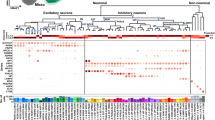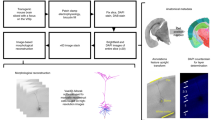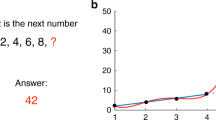Abstract
Technological advances in profiling cells along genetic, anatomical and physiological axes have fomented interest in identifying all neuronal cell types. This goal nears completion in specialized circuits such as the retina, while remaining more elusive in higher order cortical regions. We propose that this differential success of cell type identification may not simply reflect technological gaps in co-registering genetic, anatomical and physiological features in the cortex. Rather, we hypothesize it reflects evolutionarily driven differences in the computational principles governing specialized circuits versus more general-purpose learning machines. In this framework, we consider the question of cell types in medial entorhinal cortex (MEC), a region likely to be involved in memory and navigation. While MEC contains subsets of identifiable functionally defined cell types, recent work employing unbiased statistical methods and more diverse tasks reveals unsuspected heterogeneity and adaptivity in MEC firing patterns. This suggests MEC may operate more as a generalist circuit, obeying computational design principles resembling those governing other higher cortical regions.
This is a preview of subscription content, access via your institution
Access options
Access Nature and 54 other Nature Portfolio journals
Get Nature+, our best-value online-access subscription
$29.99 / 30 days
cancel any time
Subscribe to this journal
Receive 12 print issues and online access
$209.00 per year
only $17.42 per issue
Buy this article
- Purchase on Springer Link
- Instant access to full article PDF
Prices may be subject to local taxes which are calculated during checkout



Similar content being viewed by others
References
Rogers, T.T. & McClelland, J.J. Semantic Cognition: A Parallel Distribution Processing Approach (MIT Press, Boston, 2004).
Bikoff, J.B. et al. Spinal inhibitory interneuron diversity delineates variant motor microcircuits. Cell 165, 207–219 (2016).
Sanes, J.R. & Masland, R.H. The types of retinal ganglion cells: current status and implications for neuronal classification. Annu. Rev. Neurosci. 38, 221–246 (2015).
Gollisch, T. & Meister, M. Eye smarter than scientists believed: neural computations in circuits of the retina. Neuron 65, 150–164 (2010).
Badea, T.C. & Nathans, J. Quantitative analysis of neuronal morphologies in the mouse retina visualized by using a genetically directed reporter. J. Comp. Neurol. 480, 331–351 (2004).
Sun, W., Li, N. & He, S. Large-scale morphological survey of mouse retinal ganglion cells. J. Comp. Neurol. 451, 115–126 (2002).
Kong, J.H., Fish, D.R., Rockhill, R.L. & Masland, R.H. Diversity of ganglion cells in the mouse retina: unsupervised morphological classification and its limits. J. Comp. Neurol. 489, 293–310 (2005).
Coombs, J., van der List, D., Wang, G.Y. & Chalupa, L.M. Morphological properties of mouse retinal ganglion cells. Neuroscience 140, 123–136 (2006).
Baden, T. et al. The functional diversity of retinal ganglion cells in the mouse. Nature 529, 345–350 (2016).
Rigotti, M. et al. The importance of mixed selectivity in complex cognitive tasks. Nature 497, 585–590 (2013).
Rigotti, M., Rubin, D.B.D., Wang, X.-J. & Fusi, S. Internal representation of task rules by recurrent dynamics: the importance of the diversity of neural responses. Front. Comput. Neurosci. 4, 24 (2010).
Raposo, D., Kaufman, M.T. & Churchland, A.K. A category-free neural population supports evolving demands during decision-making. Nat. Neurosci. 17, 1784–1792 (2014).
Mante, V., Sussillo, D., Shenoy, K.V. & Newsome, W.T. Context-dependent computation by recurrent dynamics in prefrontal cortex. Nature 503, 78–84 (2013).
Kaufman, M.T., Churchland, M.M., Ryu, S.I. & Shenoy, K.V. Cortical activity in the null space: permitting preparation without movement. Nat. Neurosci. 17, 440–448 (2014).
Churchland, M.M., Afshar, A. & Shenoy, K.V. A central source of movement variability. Neuron 52, 1085–1096 (2006).
Hardcastle, K., Maheswaranathan, N., Ganguli, S. & Giocomo, L.M. A multiplexed, heterogeneous, and adaptive code for navigation in medial entorhinal cortex. Neuron 94, 375–387.e7 (2017).
Yuste, R. From the neuron doctrine to neural networks. Nat. Rev. Neurosci. 16, 487–497 (2015).
Cunningham, J.P. & Yu, B.M. Dimensionality reduction for large-scale neural recordings. Nat. Neurosci. 17, 1500–1509 (2014).
Hafting, T., Fyhn, M., Molden, S., Moser, M.B. & Moser, E.I. Microstructure of a spatial map in the entorhinal cortex. Nature 436, 801–806 (2005).
Fyhn, M., Molden, S., Witter, M.P., Moser, E.I. & Moser, M.B. Spatial representation in the entorhinal cortex. Science 305, 1258–1264 (2004).
Solstad, T., Boccara, C.N., Kropff, E., Moser, M.B. & Moser, E.I. Representation of geometric borders in the entorhinal cortex. Science 322, 1865–1868 (2008).
Savelli, F., Yoganarasimha, D. & Knierim, J.J. Influence of boundary removal on the spatial representations of the medial entorhinal cortex. Hippocampus 18, 1270–1282 (2008).
Lever, C., Burton, S., Jeewajee, A., O'Keefe, J. & Burgess, N. Boundary vector cells in the subiculum of the hippocampal formation. J. Neurosci. 29, 9771–9777 (2009).
Sargolini, F. et al. Conjunctive representation of position, direction, and velocity in entorhinal cortex. Science 312, 758–762 (2006).
Ranck, J.B.J. Head direction cells in the deep cell layer of dorsal postsubiculum in freely moving rats. in Electrical Activity of the Archicortex (eds. Buzsáki, G. & Vanderwolf, C.H.) 217–220 (Akademiai Kiado, Budapest, 1985).
Kropff, E., Carmichael, J.E., Moser, M.B. & Moser, E.I. Speed cells in the medial entorhinal cortex. Nature 523, 419–424 (2015).
Hinman, J.R., Brandon, M.P., Climer, J.R., Chapman, G.W. & Hasselmo, M.E. Multiple running speed signals in medial entorhinal cortex. Neuron 91, 666–679 (2016).
Diehl, G.W., Hon, O.J., Leutgeb, S. & Leutgeb, J.K. Grid and nongrid cells in medial entorhinal cortex represent spatial location and environmental features with complementary coding schemes. Neuron 94, 83–92.e6 (2017).
Krupic, J., Burgess, N. & O'Keefe, J. Neural representations of location composed of spatially periodic bands. Science 337, 853–857 (2012).
Simoncelli, E.P. & Olshausen, B.A. Natural image statistics and neural representation. Annu. Rev. Neurosci. 24, 1193–1216 (2001).
Masland, R.H. Neuronal cell types. Curr. Biol. 14, R497–R500 (2004).
Seung, H.S. & Sümbül, U. Neuronal cell types and connectivity: lessons from the retina. Neuron 83, 1262–1272 (2014).
Manns, J.R. & Eichenbaum, H. Evolution of declarative memory. Hippocampus 16, 795–808 (2006).
Shenoy, K.V., Sahani, M. & Churchland, M.M. Cortical control of arm movements: a dynamical systems perspective. Annu. Rev. Neurosci. 36, 337–359 (2013).
Fusi, S., Miller, E.K. & Rigotti, M. Why neurons mix: high dimensionality for higher cognition. Curr. Opin. Neurobiol. 37, 66–74 (2016).
Steffenach, H.A., Witter, M., Moser, M.B. & Moser, E.I. Spatial memory in the rat requires the dorsolateral band of the entorhinal cortex. Neuron 45, 301–313 (2005).
Parron, C., Poucet, B. & Save, E. Entorhinal cortex lesions impair the use of distal but not proximal landmarks during place navigation in the rat. Behav. Brain Res. 154, 345–352 (2004).
Hales, J.B. et al. Medial entorhinal cortex lesions only partially disrupt hippocampal place cells and hippocampus-dependent place memory. Cell Rep. 9, 893–901 (2014).
Klink, R. & Alonso, A. Morphological characteristics of layer II projection neurons in the rat medial entorhinal cortex. Hippocampus 7, 571–583 (1997).
de Nó, L. Studies on the structure of the cerebral cortex. Area entorhinalis. J. Psychol. Neurol. 45, 381–438 (1933).
Witter, M.P., Groenewegen, H.J., Lopes da Silva, F.H. & Lohman, A.H. Functional organization of the extrinsic and intrinsic circuitry of the parahippocampal region. Prog. Neurobiol. 33, 161–253 (1989).
Alonso, A. & Llinás, R.R. Subthreshold Na+-dependent theta-like rhythmicity in stellate cells of entorhinal cortex layer II. Nature 342, 175–177 (1989).
Alonso, A. & Klink, R. Differential electroresponsiveness of stellate and pyramidal-like cells of medial entorhinal cortex layer II. J. Neurophysiol. 70, 128–143 (1993).
Varga, C., Lee, S.Y. & Soltesz, I. Target-selective GABAergic control of entorhinal cortex output. Nat. Neurosci. 13, 822–824 (2010).
Kitamura, T. et al. Island cells control temporal association memory. Science 343, 896–901 (2014).
Ramsden, H.L., Sürmeli, G., McDonagh, S.G. & Nolan, M.F. Laminar and dorsoventral molecular organization of the medial entorhinal cortex revealed by large-scale anatomical analysis of gene expression. PLoS Comput Biol. 11, e1004032 (2015).
Langston, R.F. et al. Development of the spatial representation system in the rat. Science 328, 1576–1580 (2010).
Wills, T.J., Barry, C. & Cacucci, F. The abrupt development of adult-like grid cell firing in the medial entorhinal cortex. Front. Neural Circuits 6, 21 (2012).
Rowland, D.C., Roudi, Y., Moser, M.B. & Moser, E.I. Ten years of grid cells. Annu. Rev. Neurosci. 39, 19–40 (2016).
McNaughton, B.L., Battaglia, F.P., Jensen, O., Moser, E.I. & Moser, M.B. Path integration and the neural basis of the 'cognitive map'. Nat. Rev. Neurosci. 7, 663–678 (2006).
Stensola, H. et al. The entorhinal grid map is discretized. Nature 492, 72–78 (2012).
Burak, Y. & Fiete, I.R. Accurate path integration in continuous attractor network models of grid cells. PLoS Comput. Biol. 5, e1000291 (2009).
Bonnevie, T. et al. Grid cells require excitatory drive from the hippocampus. Nat. Neurosci. 16, 309–317 (2013).
Couey, J.J. et al. Recurrent inhibitory circuitry as a mechanism for grid formation. Nat. Neurosci. 16, 318–324 (2013).
Pastoll, H., Solanka, L., van Rossum, M.C. & Nolan, M.F. Feedback inhibition enables θ-nested γ oscillations and grid firing fields. Neuron 77, 141–154 (2013).
Sun, C. et al. Distinct speed dependence of entorhinal island and ocean cells, including respective grid cells. Proc. Natl. Acad. Sci. USA 112, 9466–9471 (2015).
Fuchs, E.C. et al. Local and distant input controlling excitation in layer II of the medial entorhinal cortex. Neuron 89, 194–208 (2016).
Ray, S. et al. Grid-layout and theta-modulation of layer 2 pyramidal neurons in medial entorhinal cortex. Science 343, 891–896 (2014).
Giocomo, L.M., Zilli, E.A., Fransén, E. & Hasselmo, M.E. Temporal frequency of subthreshold oscillations scales with entorhinal grid cell field spacing. Science 315, 1719–1722 (2007).
Garden, D.L., Dodson, P.D., O'Donnell, C., White, M.D. & Nolan, M.F. Tuning of synaptic integration in the medial entorhinal cortex to the organization of grid cell firing fields. Neuron 60, 875–889 (2008).
Giocomo, L.M. et al. Grid cells use HCN1 channels for spatial scaling. Cell 147, 1159–1170 (2011).
Giocomo, L.M. & Hasselmo, M.E. Computation by oscillations: implications of experimental data for theoretical models of grid cells. Hippocampus 18, 1186–1199 (2008).
Truccolo, W., Hochberg, L.R. & Donoghue, J.P. Collective dynamics in human and monkey sensorimotor cortex: predicting single neuron spikes. Nat. Neurosci. 13, 105–111 (2010).
Truccolo, W., Eden, U.T., Fellows, M.R., Donoghue, J.P. & Brown, E.N. A point process framework for relating neural spiking activity to spiking history, neural ensemble, and extrinsic covariate effects. J. Neurophysiol. 93, 1074–1089 (2005).
Park, I.M., Meister, M.L., Huk, A.C. & Pillow, J.W. Encoding and decoding in parietal cortex during sensorimotor decision-making. Nat. Neurosci. 17, 1395–1403 (2014).
Pillow, J.W., Paninski, L., Uzzell, V.J., Simoncelli, E.P. & Chichilnisky, E.J. Prediction and decoding of retinal ganglion cell responses with a probabilistic spiking model. J. Neurosci. 25, 11003–11013 (2005).
Brown, E.N., Frank, L.M., Tang, D., Quirk, M.C. & Wilson, M.A. A statistical paradigm for neural spike train decoding applied to position prediction from ensemble firing patterns of rat hippocampal place cells. J. Neurosci. 18, 7411–7425 (1998).
Yu, B.M. et al. Gaussian-process factor analysis for low-dimensional single-trial analysis of neural population activity. J. Neurophysiol. 102, 614–635 (2009).
Keene, C.S. et al. Complementary functional organization of neuronal activity patterns in the perirhinal, lateral entorhinal, and medial entorhinal cortices. J. Neurosci. 36, 3660–3675 (2016).
Kraus, B.J. et al. During running in place, grid cells integrate elapsed time and distance run. Neuron 88, 578–589 (2015).
Buzsáki, G. & Moser, E.I. Memory, navigation and theta rhythm in the hippocampal-entorhinal system. Nat. Neurosci. 16, 130–138 (2013).
Aronov, D., Nevers, R. & Tank, D.W. Mapping of a non-spatial dimension by the hippocampal-entorhinal circuit. Nature 543, 719–722 (2017).
Aronov, D. & Tank, D.W. Engagement of neural circuits underlying 2D spatial navigation in a rodent virtual reality system. Neuron 84, 442–456 (2014).
Dombeck, D.A., Khabbaz, A.N., Collman, F., Adelman, T.L. & Tank, D.W. Imaging large-scale neural activity with cellular resolution in awake, mobile mice. Neuron 56, 43–57 (2007).
Li, Y., Yosinski, J., Clune, J., Lipson, H. & Hopcroft, J. Convergent learning: do different neural networks learn the same representation. Proceedings of Machine Learning Research 44, 196–201 (2015).
Douglas, R.J. & Martin, K.A. Recurrent neuronal circuits in the neocortex. Curr. Biol. 17, R496–R500 (2007).
Masland, R.H. The fundamental plan of the retina. Nat. Neurosci. 4, 877–886 (2001).
Wills, T.J., Cacucci, F., Burgess, N. & O'Keefe, J. Development of the hippocampal cognitive map in preweanling rats. Science 328, 1573–1576 (2010).
Acknowledgements
L.M.G. is a New York Stem Cell Foundation – Robertson Investigator. This work was supported by funding from The New York Stem Cell Foundation, the James S. McDonnell Foundation, NIMH MH106475 and a Klingenstein-Simons Fellowship to L.M.G.; the Bio-X Interdisciplinary Initiatives Program and a Simons Foundation grant to L.M.G. and S.G.; and the Burroughs-Wellcome, the Alfred P. Sloan Foundation, the McKnight Foundation, the James S. McDonnell Foundation and an Office of Naval Research grant to S.G., as well as an NSF-IGERT from the Stanford MBC Program and a Stanford Interdisciplinary Graduate Fellowship to K.H.
Author information
Authors and Affiliations
Corresponding authors
Ethics declarations
Competing interests
The authors declare no competing financial interests.
Rights and permissions
About this article
Cite this article
Hardcastle, K., Ganguli, S. & Giocomo, L. Cell types for our sense of location: where we are and where we are going. Nat Neurosci 20, 1474–1482 (2017). https://doi.org/10.1038/nn.4654
Received:
Accepted:
Published:
Issue Date:
DOI: https://doi.org/10.1038/nn.4654
This article is cited by
-
Grid cells are modulated by local head direction
Nature Communications (2020)
-
The diversity of GABAergic neurons and neural communication elements
Nature Reviews Neuroscience (2019)
-
Novel electrode technologies for neural recordings
Nature Reviews Neuroscience (2019)
-
Viewpoints: how the hippocampus contributes to memory, navigation and cognition
Nature Neuroscience (2017)



